Like some things in life, Mizunos are an acquired taste. Ever since the Wave plate made its debut in late nineties, running shoes from the Japanese brand came with a signature ride character uniquely its own. While rest of the market rode a veritable roller coaster of cushioning trends, Mizuno has held out on its own, banking on its tried and tested technology to being the bacon home.
For the uninitiated, the Wave plate happens to be this molded, thermoplastic component sandwiched between layers of foam. There are multiple variations of it, examples being the parallel wave ( Wave Rider 18), or Infinity Wave (Creation, Prophecy). This naturally changes the ride quality, depending on the manner in which Wave is employed.
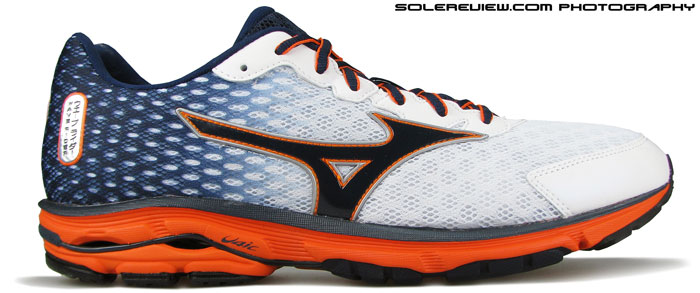
Mizuno calls this a neutral shoe, but this happens to be a different spin on the classic definition of that term.
We said that these shoes are an acquired taste, because Mizunos feel nothing like what’s currently out there in its price and category class. For a targeted neutral running audience willing to spend in the ballpark of $100, it would be fair to say that the Wave Rider 18 competes against the likes of Saucony Ride, Brooks Ghost, Nike Pegasus and the Asics Cumulus. But even in that notional framework, the Wave Rider 18 is certainly the odd one out. Where as most of the afore mentioned competitors are taking a definite turn toward increased softness, the Wave Rider is a departure from that norm. To the extent that it took us much longer to correctly ‘read’ the shoe (this being our first Wave Rider review), and be able to distil its character traits with a reasonable level of clarity.
The Wave Rider’s ultra firm ride is its most prominent element of differentiation. In fact, if you happen to transition from a non-Mizuno to one, you might be taken aback by the sheer difference. Most shoes rely on deformation of the midsole compound to achieve the desired level of cushioning. The Mizuno Wave does exactly the opposite, its Pebax sheet actually resisting deformation of the heel area. The objective? To achieve stability. This might sound like an oxymoron when we’re discussing a neutral running shoe, but that has been the original intent of the Wave system. To quote a part of the patent summary (filed in 1999) for the Wave plate used in WR-18:
“…transverse deformation of heel portion of the midsole can be prevented by the wave configuration of the corrugated sheet and running stability of the shoe can be ensured.”
So with that intention, there’s an unsurprising lack of compression when you land in the Wave Rider 18, regardless whether you’re a heel or forefoot striker. The familiar squishy feel of foam felt in other brands is conspicuous by its absence every time you land in these. What you get is a ride which borders on more hard than firm – this is replicated in the front end too, with no soft toe-offs happening.
Yet, this is the Wave Rider’s strongest suit, and the very reason which keeps Mizuno loyalists coming for more. The structural rigidity of the Wave plate, combined with layers of firm compression molded EVA, appeals to runners who want a somewhat neutral ride, only more supportive. This also helps transition, as there’s little difference in material firmness along the heel to toe gradient (12 mm drop), making the gait cycle feel much more economical. The feel is very planted, more in the forefoot than rear, and there’s a noticeable contour beneath which results in a sensation that the foot sits cradled inside the shoe, and not on it. Another way of putting this is that the ride feels lower to the ground, especially in the forefoot.
In a very non-conventional way, we found the high heel drop Mizuno Wave Rider 18 to be a good speedwork tool. The low level of compression actually helps build up pace better, compared to full foam models.
The transition being good, the midfoot base could have more supportive, by filling the under arch area of the foot instead of the recess – as pictured above.
The removable insole is overlaid atop the midsole inside, and its base is a memory-foam kind of material which is also seen in Asics and some of the Nikes. The top cloth is particularly smooth, feels premium to touch, and irritation free. The footbed is pretty thick too – our guess being around 5-6 mm and hence the only layer of discernible softness within the sole set-up.
If you break-down the rear-foot strike behavior of the Wave Rider, a couple of things come to light. Firstly, the level of responsiveness (relative to Mizuno context) varies based on where you land. Two, while the Mizuno Wave Rider is positioned as a neutral shoe, its behavior isn’t 100% so, with elements of motion control weaved into the Wave plate design. How so?
Let’s have a detailed look at the Wave Plate design used in this particular model.
The hard insert is shaped in the form of its namesake, with a pair of crest and trough visible in the midsole wall. There are twin gaps in the midsole foam, one below the crest and another above the trough. The highest level of responsiveness is achieved when you land on outside rear-foot, just above the trough+gap area. This causes the molded piece to stretch out, and rewarding you with a minuscule level of springback. However, if you tend to land on edge of the heel, it feels flat, as the material in between has two layers of foam and Wave sandwiched tight.
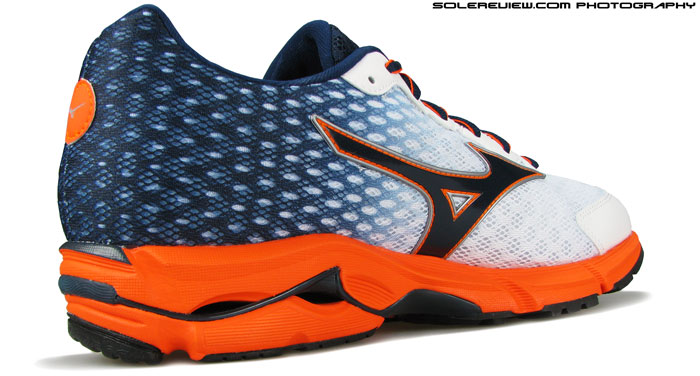
Look at the Wave design on medial side, and you’ll notice that the crest is higher, along with a thicker midsole wall. This influences footstrike and transition mannerisms, making the Wave Rider semi-neutral at best.
Rear-foot compression during foot strike ends up being laterally biased, which adds in a smidgen of pronation control. The midsole wall and Wave design isn’t uniform, being structurally asymmetric (intentionally) across lateral and medial sides. Lateral (outer) side is slightly thinner when compared to medial (arch) side, where the midsole is thicker by a few millimeters. The curve of the Wave plate is more aggressive on the medial side, with the crest pointing higher than the lateral face. This makes the medial midsole much firmer, with less ‘give’, leaving the lateral side to be more compressive.
So in short, when you land, the Wave Rider keeps the rear-foot contained laterally, and inward roll is minimized by the higher midsole wall and pointy crest of Wave plate.
This also gave us the sense that Mizuno’s Wave platform’s level of responsiveness increases with a corresponding decrease in thickness of the top and bottom midsole layer. The outer side is where you get more feedback from Wave’s deformation, whereas that feeling is insulated by the chunkier midsole medially. Can’t say we have much experience wearing Mizunos, but if the Mizuno Wave Sayonara 2 is anything to go by, a thinner midsole helps elevate the snapback of Mizuno Wave. This observation only applies to non-Infinity based Wave, naturally.
Outsole is split into two distinct sections. Extremely hard rubber (X-10 in Mizunospeak) lines the underside of heel in a horse-shoe arrangement, with a crash pad separated by flex grooves. In the front, Mizuno goes easy on material density, instead preferring to use a softer type of rubber.
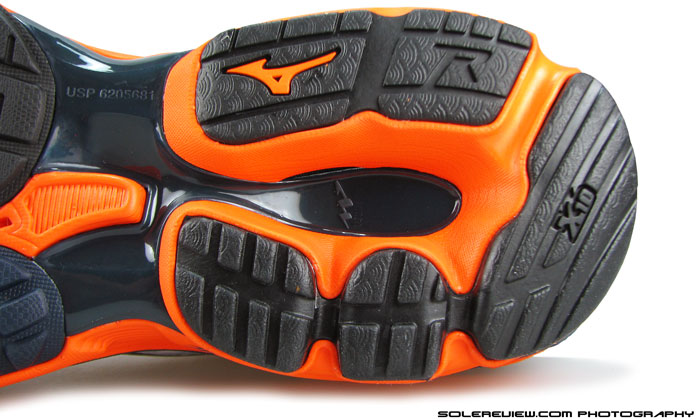
Under heel outsole is in shape of a horse-shoe, using a hard density of rubber. Heel crash pad is segmented, but has a very limited range of motion due to material firmness of the midsole.
Just how hard is the heel rubber? Enough to make a racket every time one foot-strikes, as if running in a pair of dress shoes. The crash pad also lacks a range of motion as it is stuck to the combined firmness of midsole foam and Wave. Instead of the crash pad breaking away with each landing, the end result is a somewhat abrupt contact with the running surface, an action which feels and sounds hard. We’ve started seeing signs of wear on the crash pad, but then the extra thickness of Wave Rider 18’s outsole should hold out long enough.
The forefoot is far better, with soft rubber muffling transition or foot-strike, depending on your running style. Flexibility is average, with firm materials resistant to bending. Will that aspect get better with time? Sure, and that’s true not only for Mizuno but for most EVA midsole based running shoes. Pile on 100+ miles, and the tensile+compressive response of EVA will decrease due to material fatigue.
Wave Rider’s upper relies on basic construction, with some nice visual tricks thrown in. Majority of the upper is made with three pieces of breathable spacer mesh, and twin Mizuno logos go over the seams joining parts of the upper. This delivers the illusion of a single piece mesh upper. The fabric in the back has color sublimation, with dress blue color fading from dark to light in a gradual, ebbing way. On the heel, there’s a glossy piece of welded TPU in silver (first picture in this review) which calls out the familiar model name in English and Katakana Japanese. Reflectivity is meant to be served by a blink-it-and-miss-it Mizuno Logo printed on a circular patch. Not very useful, really.
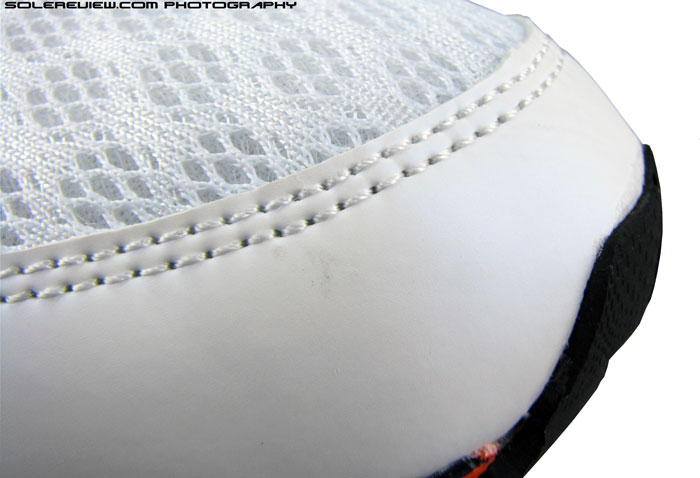
Synthetic leather used on the toe bumper and eyestay has a pearlized finish. Can you see it? Can you?
The synthetic leather has a pearlized finish which is hard to see in online pictures (we’ve tried hard to replicate the effect in a photograph here). Nothing special in the way it’s being used though, just forms the toe bumper and traditional eye-stay. The collar fabric feels premium, though with relatively spartan padding. The tongue is soft, thick and padded, and has a trick up its sleeve which we did not even notice initially. You see, the tongue doesn’t come attached to the upper, so it should obviously (and expectedly) result in tongue slide, right? It doesn’t, at least not to a noticeable degree.
It’s actually very wide, which means that the edges extends deep on either sides of the foot when properly laced up. It fills up any empty gap(s) between the upper and foot. Now tongue slide will only happen when it has some space to slide in. But with room filled up, there’s nowhere for the tongue to go, so it stays put. The lacing is fairly wide, and the plush tongue takes the overhead cinching pressure extremely well.
On the other hand, laces used are a disappointment. The Wave Rider 18 uses a two toned type which tends to twist a lot, and during our wear-tests, we noticed that they tend to come loose if you don’t tie them tight enough. Two tone laces are not faulty as such; Brooks uses a similar design in shoes like the Glycerin and the Beast. Soft to the touch, they maintain their orientation and don’t come undone either.
Wave Rider 18’s fit is worth spending some time talking about. The upper is very roomy, and that applies all across. Starting right in the heel area where there’s a good amount of lateral slack, to the midfoot which feels relaxed, and finally in the forefoot which is very spacious. The unrestricted mesh upper on sides allows generous splay area, and there a full half size extra in length too. We got a US 11 for this review, yet feel we could have done with a 10.5 too.
That said, always try the shoe on for yourself as foot anatomy will vary. And coming back to the heel area – the relaxed fit did not bother us and we saw no slippage, but it isn’t exactly confidence inspiring. If having a snug heel ranks high up on your list, make sure you try the Wave Rider on to know what you’re getting into, literally speaking.
Like some of the recent shoes reviewed, the Wave Rider 18 also suffers from barefoot non-compatibility. There are these two seams inside just under the Mizuno Logo, and they bite into the sides if you decide to run without socks. There’s another pair of soft underlay just ahead of the seam, meant to prop up the mesh upper and prevent the latter from losing shape. But these aren’t a bother, only the seam is.
That pretty much sums up the latest version of Mizuno’s popular model. A semi-neutral yet supportive ride, roomy upper, decently lightweight (300gm /10.6 Oz). If you’re into your nth pair of Mizuno, then whatever we’ve laid out in the review will sound familiar and hopefully make sense. Perhaps you can leave a comment or two to tell us how this shoe compares to 17th edition and prior, or to some of the other Mizuno you own.
If you’re new to the Mizuno club, then don’t get misled by adjectives being thrown around on the internet when it comes to the Wave Rider 18. You’ll see comments with words like ’smooth’, ‘very cushioned’ and the like used liberally. Not that they’re wrong in saying so; just that the usage of those words is highly contextualised.
The Mizuno Wave Rider 18 is a running shoe with a unique behavior set, differentiating it from the adidas, Nike’s and Brooks of the world. As long as you respect that difference, and accept the Mizuno for what it is, you won’t be disappointed.
(Disclaimer: Solereview paid full US retail price for the shoe reviewed)
Note: Starting this review, we have discontinued the practice of numerically scoring individual footwear attributes. Instead, we use the same rating methodology and arrive at a single numeric score. Some of the elements from the numerical rating have been included in the sensory scoring format.
Here’s the range: Great (dark green) – 90%- 100%, Good (light green) – 75%- 89%, Average (amber) – 60%- 74%, Poor (red) – lower than 59%


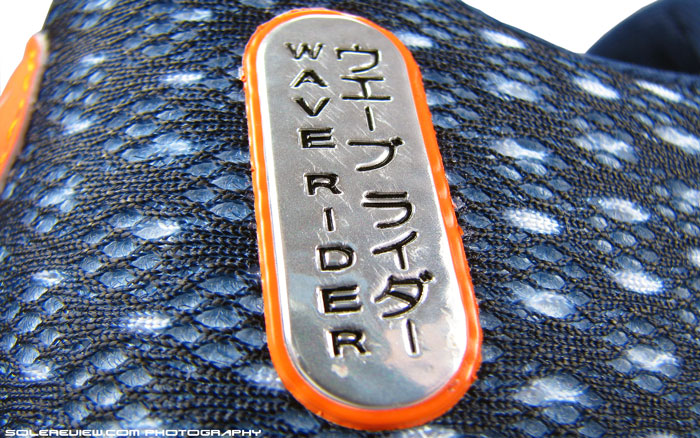
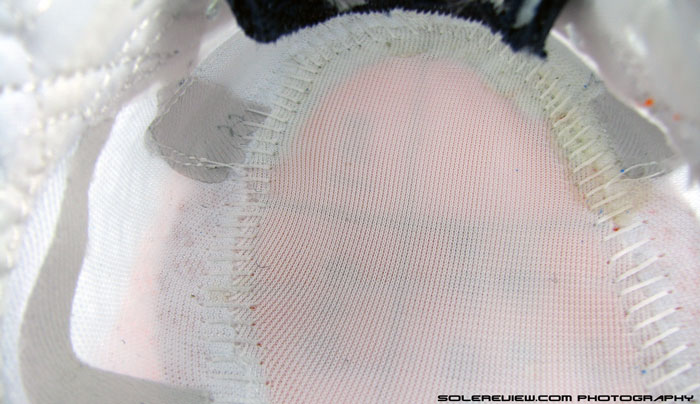
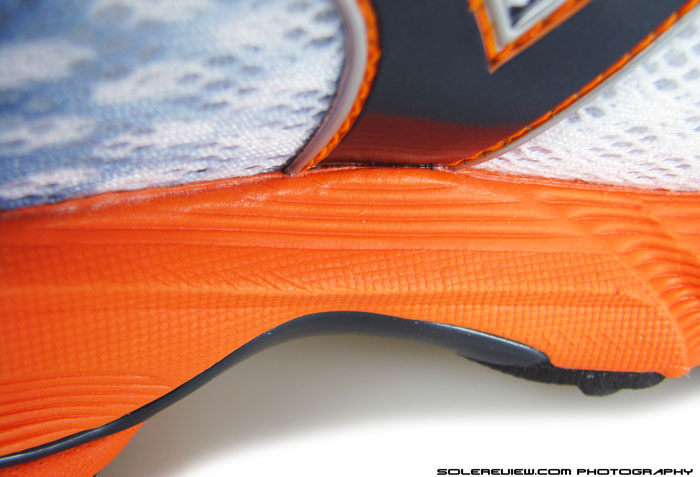
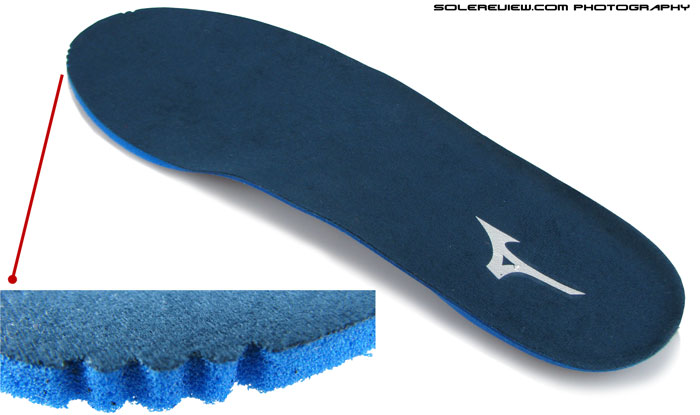
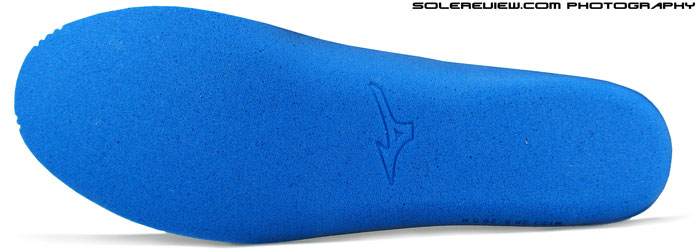
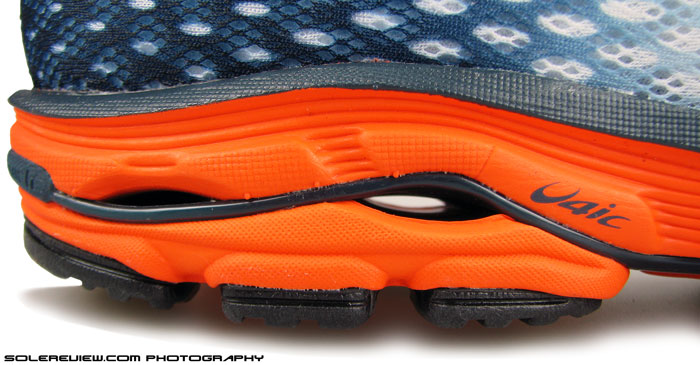
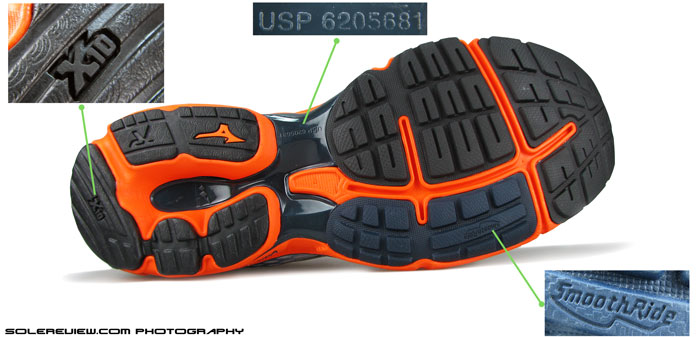
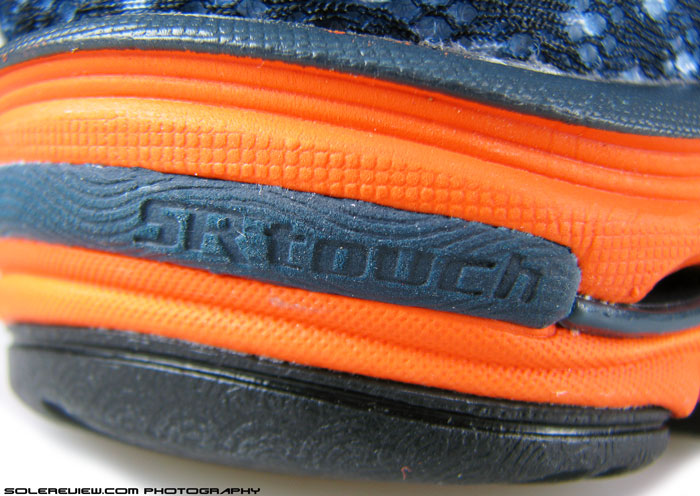
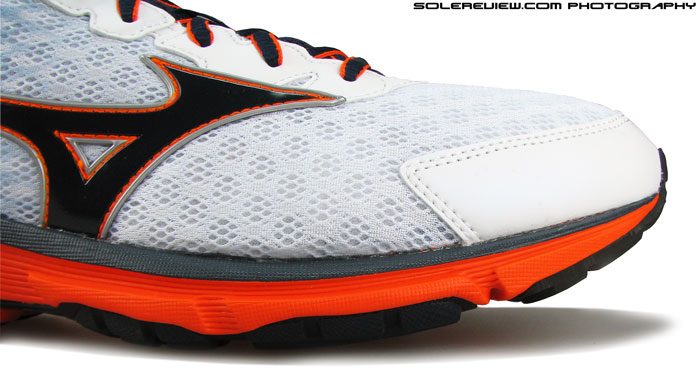
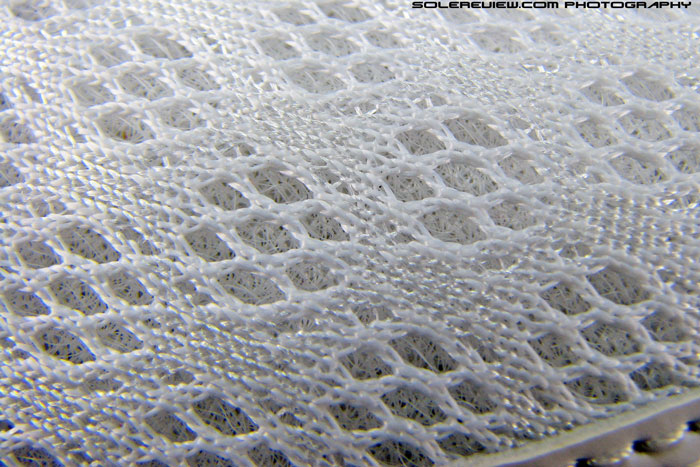
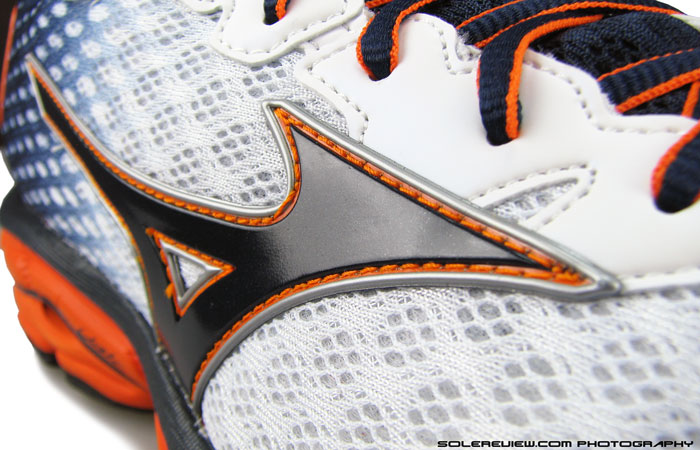
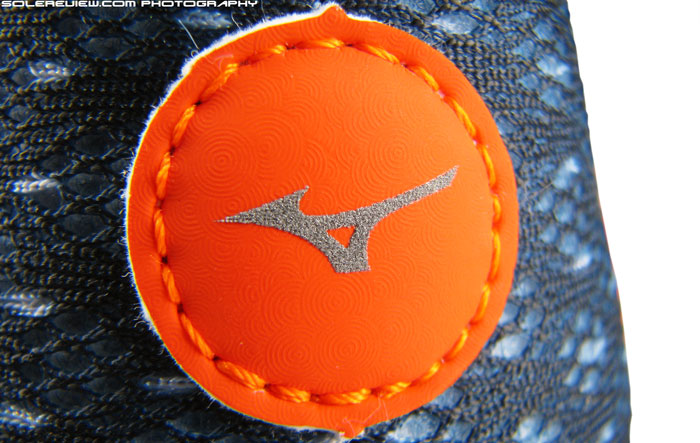
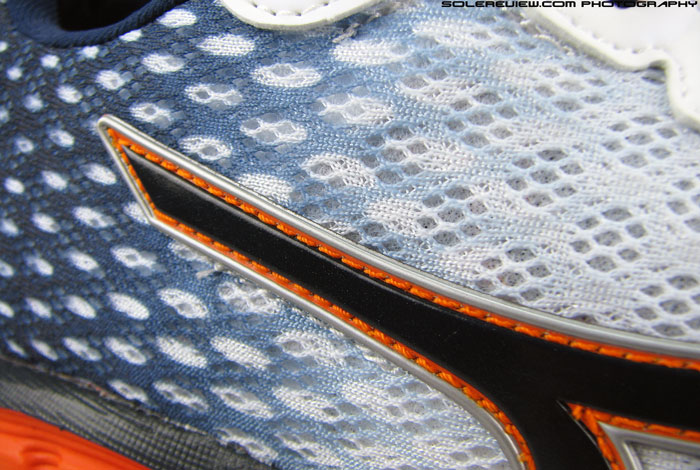
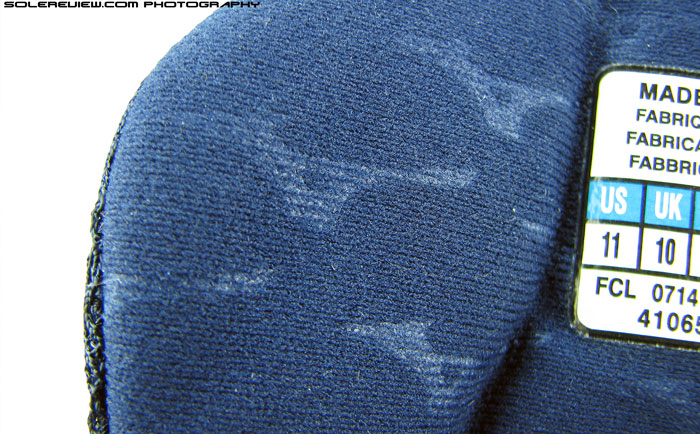
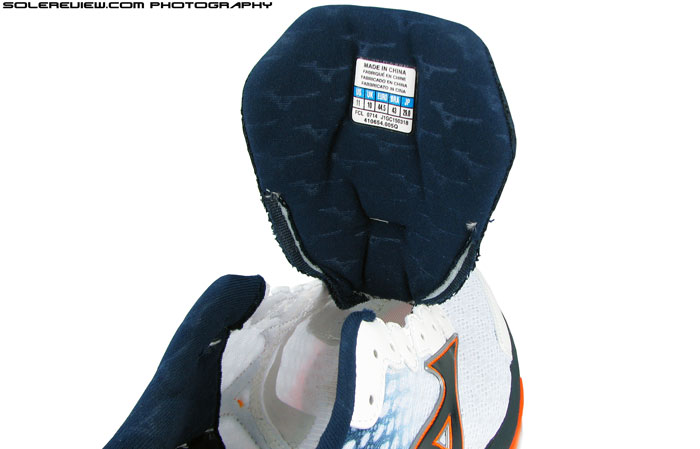
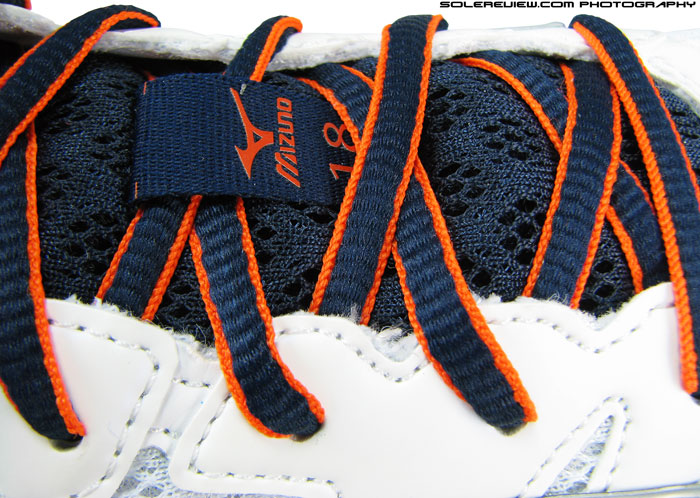
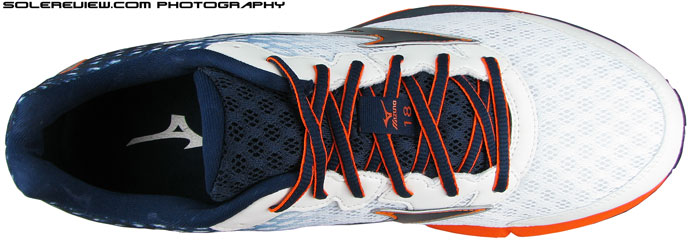
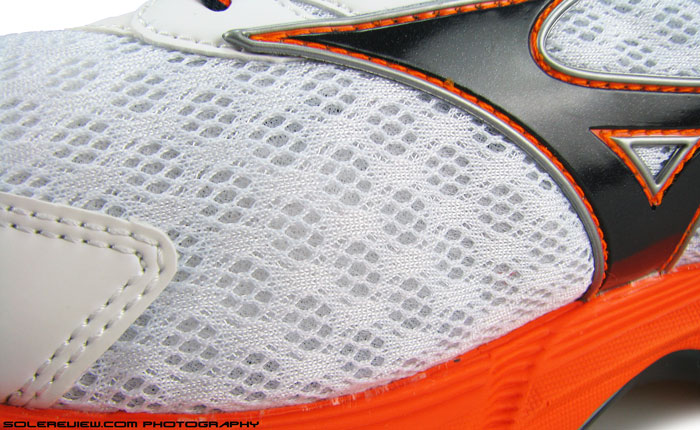
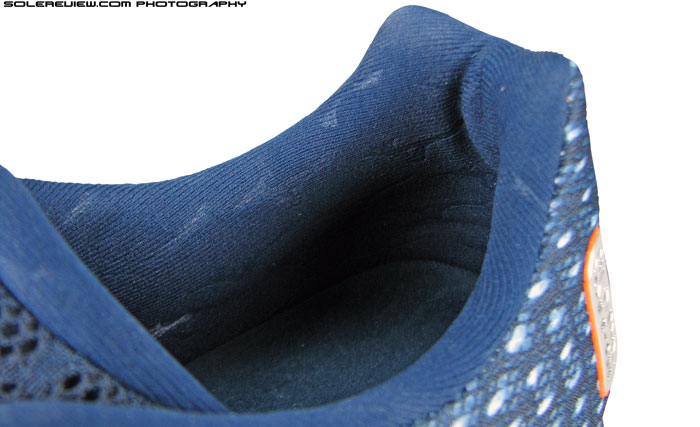
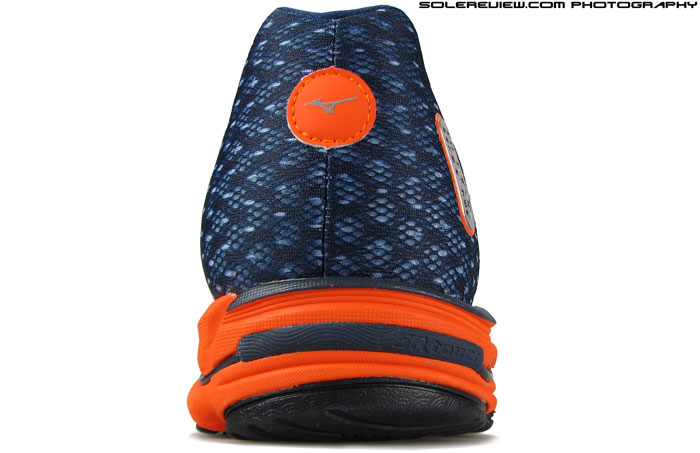
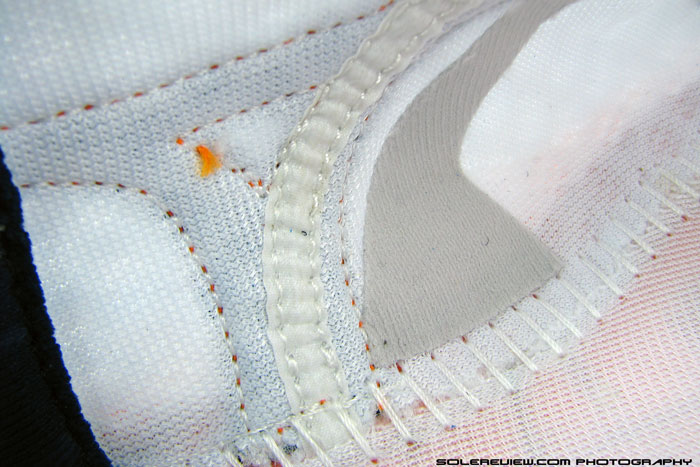
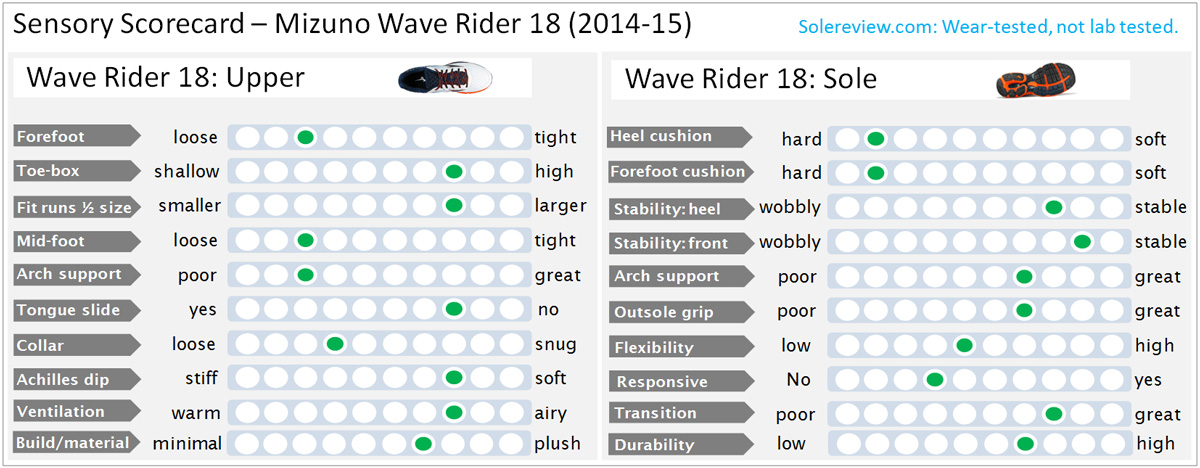
69 comments
I am currently running in the Mizuno Wave Rider 17 and have used it for runs up to 10 mi and I was wondering how the room in the forefoot and cushioning in the forefoot compares with with Nike Pegasus 31 and Nike Zoom Elite 7. I am dealing with a bunion causing my 2nd metatarsal head to drop and would like a roomier forefoot with maybe a bit more cushioning. Would the Nikes be more ideal? The upper fits really well on Mizuno’s and keeps my heel from moving around.
Hi, the Peg 31 is snugger either in lenght and width than the one of the Mizuno 17.
Here’s a quick summary:
a) Wave Rider’s forefoot is wider, longer, and comes with a higher toe box than Pegasus and Elite. In terms of width, this is the order – Mizuno, Pegasus, Elite. The Nike’s have similar room in front of the toes, and shallow at the tip. If you need more room, then the Nike’s aren’t for you.
b) Cushioning in order of soft to firm: Pegasus, Elite, Wave Rider 18.
Hope this helps.
I have the Wave Rider 17 in both B and D widths and it’s strange how the Nike Zoom Wildhorse feels wider in the toe box than the D width. I have looked at shoefittr and it claims the Zoom Elite is a smidgeon wider than the Wildhorse which is why I am asking.
To be honest, don’t how the WR-17 compares. Our comment was specific to the Wave Rider 18.
ShoeFitr is a great tool, but isn’t perfect. While we’re not 100% sure of their scanning methodology, it would seem certain that their measurements don’t account for degree of material stretch once the foot is inside the shoe.
What a sophisticated review, being a Mizuno fan for many years, I havn´t read anything up to date that explained the “Mizuno ride” that well. Most of the time I run on my forefoot and on forest paths, up to 15 miles. What drove me to Mizunos was their wide fit in the forefoot, light weight, snug heel and responsive cushioning and last but not least, great durability of the outsole rubber and cushion, in fact Mizunos tend to become softer over time but the cushioning doesn´t break down like with other shoe brands & they all felt close to the ground and fairly fast. Unfortunately I never tried the Wave Rider (always thought that they are too much shoe to promote the Mizuno ride well).
I startet with the Mizuno Elixir 4 (lightweight support) that almost had no cushioning and continued whith Precision 11&12 and a Trail shoe (that was crappy) – what was the name…. Ascend 6, I believe. My favorite Mizuno is the Ronin 3 – it is a neutral racing shoe – it fits even my wider forefoot without being a “wide – slow & clunky” shoe, the outsole is covered with Mizunos X10 rubber (I believe in the forefoot too) and after 3 years of running (not too often, maybe 500miles in 3 years) it still looks almost new. Same with the cushioning – the heel is ridiculous hard – but the forefoot is fantastically responsive and grippy.
That being said, newer Mizunos don´t “wow” me the same way. Tried the “evo” line – Cursoris, Ferus and Levitas which have the wave plate in the forefoot (sounds like a wet dream, right?) but the outsole rubber is not durable at all (200 miles, then it´s “gone”) and the fit is somehow a little off, with looseness and tightness in all the wrong areas – the laces hamper a secure fit too. But the wave-plate-ride and cushioning of their ap midsole (that was before the new u4ic) material is more energy efficient and longer lasting than almost anything that other companies have (at least in my book).
Mizunos still have a place in my rotation but I somehow run more often in other shoes (NB 890, Kinvara 5, Nimbus 15, NB 1210 etc).
If I was a heel-striker I wouldn´t run in Mizunos at all, because they don´t feel stable on forest paths (with some gravel, roots, mud) and little stones tend to get stuck in their horse shoed heel (and I don´t really like their trail shoes, except the ferus). Even on roads the heel section (tried it) feels harsh and the impact is way too hard for me. But as a forefoot runner, they feel much better, fast, low to the ground and the hard rubbered outsole works like a rock plate.
The odd one was the Precision 12 that felt the softest of all the Mizunos I´ve tried – borderline mushy even in the heel. Didn´t like it at all because it was slow and unstable without that fast “zip” feeling.
Bottom line: When looking for new shoes, always try some Mizunos, because they could surprise you.
Ok, that´s my Mizuno story^^ Sorry for the long post.
It would be interesting if you guys could review a Mizuno with the older AP+ midsole material (like Ronin, Elixir, Precision, Rider 16) and compare it to the current models in terms of rebound quality of the midsole. I read some negative comments about the Sayonara being much firmer in the forefoot than the older Mizunos (maybe same is true for the rider?) with AP midsoles and not suited for forefoot/midfoot runners. I believe that the recent application of more blown rubber in the forefoot of some Mizunos is a way to smoothen the ride, but it decreases durability.
The Mizuno Enigma would be an interesting max. cushioning Mizuno. Version 1-2 have AP+ and 3-4 u4ic.
Gotcha, thanks!
Regarding di Rider, from the 17th is softer than the Ap+ versions.
Thanks Francesco, if you still have the 16th version could you please look if the outsole rubber is x10 in the forefoot and whether the sockliner feels the same between the two versions?
The 16th has x10 throughout the midsole. Mizuno started usding blown rubber in the forefoot with the 17th version. The fit is quite snuggier in the 16th, compared to the 17th that is 1/2 size bigger than usual, mostly due to the flat and wide forefoot.
Maybe the blown rubber has something to do with the softer feel. Very interesting, thank you.
Great idea, let’s see if we can find a window in our schedule to slot that in. So far, the only AP+ based Mizuno review on solereview is Prophecy, which in context of your suggestion, is pretty pointless to draw comparisons with.
Great, really appreciate your work! I guess the Sayonara & Rider 18 are good reference points for newer Mizunos and maybe sometime in 2015 there´ll come an (suitable) AP+ Mizuno your way :)
Charles, I conducted an interesting experiment comparing my new Inspire 10s with 500km old Inspire 9s – by running a few kms with one on each foot. The Inspire 9’s AP+ midsole felt simultaneously softer and more responsive. In comparison the new midsole (euphoric?) felt dead and overly dense. For me the 9’s old AP+ cushioning was better than the 10’s new midsole.
Thanks for the insight, Steven. That would be consistent with some user comments. Unfortunately I haven´t much experience with the new midsole material – U4ic – but I do love the ap+ stuff.
Thank you for the detailed, informative and insightful note. We tried our best to break down the Mizuno Wave Rider for what it is, so happy to hear positive feedback.
As reviewers, we’re wet behind the ears when it comes to Mizunos, so the best thing to do right now is to absorb the information in your comment for future reference.
Since you brought it up, we have plans to review the Wave Hitogami 2 in January.
You´re welcome – looking foreward to the next reviews.
Great review as is the norm.
I have the WR17 in my rotation. Other shoes are the Ghost 6 and Vomero 8 and 9. I added the WR for a lighter shoe but notice the WR18 is an ounce plus heavier.
I have a narrow foot so not bothered by the fit issues some experience. I love the flexibility/comfort of the WR17 upper, but the stability of the wave plate, as you succinctly describe, does cause my knees to be tender at times ( I am a supinator).
I have worn the WR and the Creation occasionally in the past and find that the transition has decreased over the years. The transition in the WR13 and Creation 9 was great, similar to the Ghost.
I completely agree with your comment that the WR is a different shoe for those that are not familiar with Mizuno. To me the pros are fit, comfort, and responsiveness due to being a firm shoe. That said, I doubt adding the WR18.
Hope to see comments from someone who wears both the WR 17 and 18.
Thanks again for the great review.
Great insight(s), thank you for sharing! Adds perspective to WR-18 in context of the 17th version, which is helpful both to us and other readers.
We’ll be reviewing the new Creation sometime next month or in January.
Well its been hmm about 900km
well I am breaking the pair in. Went from 17 to 18, but need to put more than 20 miles to say anything…
https://scontent-a.xx.fbcdn.net/hphotos-xfa1/v/t1.0-9/1549358_1004898649525989_2143419629696952940_n.jpg?oh=0fadd0d41c3c68ae109adf08c298a4c4&oe=551A455D
You guys should really consider reviewing the wave paradox. They are a complete 360 from these…supportive, lightweight, with tons of cushioning
Appreciate the suggestion, the Paradox is on our radar too. Waiting for Paradox 2 to hit the market in January.
January? I thought July. Regardless, I would love to see your review of the Paradox. Also Inspire 11, if I can be greedy.
The release cadence is January, so we’ll try to review it in the same month. No problems with the new Inspire, that’s going to be in December.
Excellent, thanks. Especially looking forward to the Inspire review, as it’s my main shoe. Love the site (and the most comprehensive and informative shoe reviews I’ve seen). I’ve just discovered it but get the feeling I’ll be here often ;-)
another great review by Solereview. A big Like and Thumbs Up to you guys!
Thanks BC Oi!
I so much wanted to love these shoes as a sister to my Sayonaras. I walked in them a lot and went on a couple of short spins in them and I thought they were going to work. However when I tried to go on a 30 minute run I determined they weren’t going to work at all and changed out of them after 20 minutes after stopping several times to try to loosen them around the mid foot to no avail. First off the laces are too short, but even so they were much too inflexible to the point where they felt like they were crushing my mid foot and I had to get them off before I incurred foot damage. In a nutshell, too hard too loud and too stiff. Your review is very accurate.
These shoes are unlikely to have universal adoption, precisely for the reasons you’ve mentioned. There’s a high degree of ‘Mizuno-ness’ in the Rider 18 – ultra firm ride and footstrike noise.
Dis you run with rider 16 or 17 before ? I loved both and i wonder if you could compare
No I havent, I’m new to Mizunos.
I’ve run in the wave rider for years and loved them until the 17. The upper cut across my foot when I’d bend it. I decided to wait for the 18. I got the 18, and it felt too cushy to me in the forefoot. I could live with that, but on only my 3rd mile, my hips and outside of my thighs started bothering me. I can run a half marathon in my old beat up 16’s but not more than 3 in the 18’s. They are too rigid. I’ve been searching for a replacement and haven’t found one yet. Any suggestions?
How about the Wave Sayonara 2? Have you tried them?
Not yet, but that’s because my running store doesn’t carry them.
Since you’re used to Mizunos, the Sayo’s are worth a try. Not really sure why you’re experiencing the pain from the Riders.
I too had a problem with the riders for a while, but I had issues starting with the 16 and just got back into them with the 18. I absolutely loved the 15. I would have to agree that the Sayonara is a great shoe, it is more flexible and lighter than the rider, but still durable and very comfortable. Give it a go if you have the chance.
Interesting review! I’ve used almost exclusively Wave Rider for 3 years now, and have been quite happy with WR 17, I actually prefer it to #16, but for off road running and now in winter, they’re a little thin in the front (on the other hand, the heel doesn’t collect ice, stones and pine cones like the 16s do :-)). For this reason, I bought a pair of Enigma 4 for this winter, and it’s a great shoe too, but it doesn’t quite have the “ground contact” of the WR 17 – the Enigma has a quite thick sole in the front and an extreme rigidness (but I like that Enigma has a 10mm drop, less than WR). But for my next pair of shoes in the spring, I’m wondering if I should try something else than Mizuno again for a change, and have looked at the Adidas Adizero Boston Boost 5. Any Wave Rider users here that have tried those?
The WR-18 and BB5 are shoes with two completely different characteristics. The BB5’s snugger, lighter and more responsive in cushioning feel. Not a familiar sight from where you’re standing, but that level of differentiation makes for good variety in your running shoe rack.
Having owned both, I would say that the BB5 is actually looser in the mid-foot and tighter in the toe, while being less responsive and much softer, although it’s lightness helps with that, and it is responsive for such a soft shoe, just not as much as the Mizuno. I don’t mean to contradict you so much, just wanted to give another opinion on the two shoes.
On a another note, I really love the website, will be reading more of your reviews.
Thank you for the feedback!
Opinions on the same running shoe varies across different runners, so we’d actually think it unusual if everyone unanimously agreed with our review :)
Thanks for the helpfull review! I have a narrow foot and wear Mizuno WR2A since the 15th. The 16th2A is absolutely my favorit but the 17th2A I almost dont wear. They are too soft and are more ‘shoe’ than the 16s. In longer distances like 20+Km’s my knees are starting to give pain. This is NOT happening when i wear the old hard 16’s. However, those almost dont have profile anymore after 2 marathons so I absolutely have to buy new ones before my planned mt in april.
My second shoes are the Adidas supernova boost glide. I like them, but love the old mizuno. Can anyone give me advice about what to buy? The 17 are such a dissappointment that i am a little hestitated for buying the 18…
thanks in advance!
Can’t say about the WR-17 since we haven’t tested them, but if you need ‘less’ shoe, then the Sayonara 2 might just be the tool.
Great review; I wish it was published a few days earlier before I bought a pair of the 18’s :)
I had been happily running in Sayonara’s but found they wore out extremely quickly. I run about 50 – 60km a week, weigh about 48kg and am a toe runner. After visiting a podiatrist I was told to get a pair of Asics Nimbus ( I also have custom orthodics for a bunion). The Asics feel very bulky and high compared to the Sayonara’s and the previous New Balance shoes Iv’e had in the past. The sales guy recommended the 18’s over the Asics and said that the podiatrist gets a commission from recommending Asics and the 18’s were a much better shoe.
The 18’s felt like home as soon as I put them on but on the first run I lost skin on my little toe ( no big deal but uncomfortable), after about 4 times wearing them now and about 60km later I have some dull shine and foot pain similar to wearing a stability shoe.
The perfect pair of runners probably doesn’t exist but can anyone recommend a neutral running shoe with a medium – wide toe box that would suite a toe runner? Or if the Asics Nimbus are worth getting used to the extra bulk?
Thanks:)
How about giving the recently released New Balance 1080 V5 a try? In stock D sizing, it has ample width, and additional widths are available too. They will run softer than the Sayonara or Rider 18 though.
Great review on the Wave Plate technology, thanks for posting. I am on my fourth pair of Wave Rider 17s and, until I wear them out, I’m sticking with them as I love the 17s and prefer them to the 16s. I used to run in the Asics Nimbus but the Mizuno’s WR’s lightweight, ventilation and responsiveness mean they are all I run in now. My concern with the 18 is the return the to the curved to end like the 16s, so I’m going to see what the 19s have in store.
Thank you for the feedback. We don’t have miles on the WR-17 so useful to hear your point of view.
For 800-900 Kms the shoe looks pretty solid, and like you say, it seems as if there’s much more life left in them.
Appreciate the photographs and the accompanying insights!
As usual, thank you for the in-depth review! I would just like to ask if you’ll recommend this for a runner that tends to underpronate like me? It seems like in other sites, the Wave Rider is a common shoe suggestion for underpronators, but the hard cushioning of this shoe troubles me
Hi Clar,
we find it hard to recommend shoes based on pronation. All we can say is that the Wave Rider 18’s midsole is pretty hard – now whether you like that part or not depends on what you prefer in a shoe.
A good way to go around this is to base your purchase on a shoe which worked for you in the past, and particularly what traits of that shoe you found appealing.
This is way in the seeds, but if you look at the x10 stuff on the heel, you’ll see circular patterns; they look like a shout out to the outsole of the rider 17!
Figured you guys, being so in depth, would appreciate the finer detail of this :)
Spot on review. I recently moved to these from the Inspires; way too much motion control for me in those. These, like you pointed out, have a good balance of neutral while being stable (:
Thanks! Did not notice that, because we did not have a 17 at hand. The Rider 18 is a great shoe, but only when one manages expectations around the shoe’s character/ capabilities.
Hi Guys,
First of all I just discovered your site today and must say this is one of the best I have seen so far. Reviews are complete with a lot of context and comparison to other models, so I will take this opportunity to thank your for your remarkable work (it is so technical that as a french reader I must concentrate :p)
I am in a particular situation regarding running and was hoping you might help.
First a bit of context : I am a tall (1m86), middle-weighted runner (71 after marathon prep, 74 usually).
I ran my first half (1″29) and marathon (3″29) in 2014 using Mizuno’s Rider 16 and then 17.
Afterward I chained several injuries from periostitis to lately a detachment of the aponeurosis on both calves (hope that’s the correct term) canceling my participation to the 2015 Paris marathon.
I am going back to run after a full 2month break with the 2016 marathon in mind and look for shoes (or several !) to achieve this new goal.
During this year I tried several shoes :
• Nike Vomero 9 : did had the chance to do a lot of runs with those but what I really dislike compared to the Mizuno’s what the breathability. Felt like in an hoven in here
• Adios Boost 2 : I really like those. They feel a bit to close to the feet, especially in the middle, but are really light and still offer a great responsiveness when running. I ran the 10k in 40″ wearing them. Still I wonder if continous run with those might have led to my aponeurosis issues.
That’s why I think I should move to a more protective shoes for marathon preping (and maybe a new pair for the race or short/specific trainings)
I narrowed my list to those shoes (excluding brands I do not know like Asics or Saucony but fell free to suggest :)) and was wondering if your could back up my analysis and maybe ass so though in it :
Ones I could “test” :
• Adidas Response Techfit : just tried those at the store (but on 100m for what it’s worth) and they feel really tight with this mech on top – unbreathable. On the other hand really good response (like many Boost shoes)
• Adidas Energy boost Reveal : same. Are those the same as Energy Boost 2 ? (so many models) you tried here https://www.solereview.com/adidas-energy-boost-2-review/
• Mizuno Wave Rider 18 : Also tried at the store on short distance, slow pace. The shoes feel wide (but a bit less than the 17 I would say or I got used to it) and you can really feel the air inside when running. I personally appreciated it. They seem to have a good response too.
Ones I also had in mind :
• Adidas Supernova Glide (7 or Sequence) : I feel those will be to heavy even for training
• Adidas Ultra Boost : may be to heavy too
• Adidas Adistar : too heavy
• Adidas Boston : Seems like a decent shoe for both prep and the race, a bit softer than the Adios I believe
• Adidas Energy Boost ESM : I believe this is the ESM version of the Energy Boost Reveal mentioned (with the number 2 lost -_-) above which could be a great compromise between weight, response and “softness”. Could even fit for the race day
Thanks a lot for your work and response
Nicolas
Hello Nicolas, thank you for the kind words! We try our best.
Based on what you’ve described, we can narrow down the selection factors to the following three. We’ll try and provide our perspective on your selection (and our recommendation) based off this list.
Should be breathable
Should be lightweight (315 gms) or lower.
Should be well cushioned, but without sacrificing responsive-ness.
Vomero 9: Yes, this shoe feels a bit stuffy inside because of its mesh structure/inner lining. If you liked everything else about this, then we would suggest that you try the Vomero 10. The mesh isn’t as well ventilated, but the looser fitting upper allows some internal circulation.
Adidas Adios 2 Boost: The midfoot is tight, correct, but since you seemed to have liked most, the Boston Boost is worth trying. More room and cushioning over the Adios, yet lightweight and breathable.
Energy Boost Reveal: This is built on the same platform as the Energy Boost 2 (the one we reviewed), but with a different mesh upper. We did a PureBoost review (don’t buy that!) which had a ‘Reveal’ upper. The ESM version is nice, except for the tight midfoot and slightly firmer forefoot (the heel is much more cushioned). If you’re ok with that, then give them a try.
Mizuno Wave Rider 18: Should be ok based on your fit test experience and ownership of the earlier Wave Rider models.
So in short, out of your list we saying that you should try the Vomero 10, Boston Boost, Energy Boost 2 ESM and the Mizuno Wave Rider 18.
Apart from those, we also suggest that you give the Saucony Ride 7/8, Nike Flyknit Lunar 3 a fit trial too – once you’ve had the chance to try the other models.
What did the doctor/physio say about your injuries? Both of the conditions appear to be overuse related, and what kind of exercises around strengthening/conditioning exercises along with modifications to nutrition intake did you include in your marathon prep? If you ask us, that along with focus on running form matters much more than shoes.
Hi,
Thanks for your advices. I red somewhere that Nike’s shoes did not last as long as the other but that might just be wrong.
Regarding my injuries it is a bit of a blur too. I wore orthopedic insoles and had to change during training. It might have led to the periostitis but I believe this is mainly overuse :)
I consulted a new podiatrist a few weeks ago before starting again and he concluded 2 things :
• My ankles are not aligned with my foot, which might cause a compensation at the lower leg level and might have led to the aponeurosis issues.
• The new insole I had were not adapted because this can actually be fixed (in a 5 year time ..) where the old insole only were for comfort and not correcting the issue.
I am not running with the new ones, only wearing them day to day, will see how it goes.
I did not had a particular diet for marathon prep as far has I recall. A bit more protein and recovery “shots” (prot + sugar) after long runs but that’s basically it as I am trying to keep it healthy all the time. Well I surely had less alcohol during prep limiting parties but that might be a good thing :D
Injuries can be complicated, and hope you don’t have to face any of that in the future after recovering.
Give the shoes a try and see what works for you best. Nike doesn’t lack on durability in our experience, as we’ve seldom had an issue.
Hi Guys,
Getting back to give you a bit of feedback, might help someone else.
I went to the store and tried the Saucony Ride 7, Mizuno Wave Rider 18 and Adidas Response Boost ESM.
The Response Boost is a great shoes. The Boost give you a lot of energy back and since there is a lot of it the shoes is very smooth. A bit to soft for me that is. You can really feel your feet ‘deform’ the sole.
The midfoot in the ESM version is quite tight (Adidas!) but not as much as the non-ESM version.
The Mizuno Rider 18 is great. but is really harder. It is really a particular shoes (the 17 was too) and you should really try it before buying it. I personally loved the 17 and does not mind a bit of firmness. (I weight 70kg – avoid above 85 I believe)
Finally the Saucony Rider 7 is great. The 8mm drop truly gives you a “punch” forward as a mid/front foot-runner. The shoes is not as soft as the Response, not as firm as the Rider and is a great compromise (if you are a mid/front food runner)
To conclude I went to for the Saucony that I am currently using as my recovery shoes and will be using for long distances. Also bought the Mizuno’s for more specific training (and more if knees and stuff support it).
Oh, and of course I kept the Adios Boost for really short distance or 10km competitions :)
Best
Nicolas
Hi Nico,
Thank you so much for coming back and sharing your feedback, very helpful! :)
I never write reviews but I felt like I needed to share this information with the world and see if anyone else is in the same boat.
I LOVED the mizuno rider 16. BEST shoe I ever used for training. I bought about 6-7 pairs of them. Ever since they discontinued the 16 and turned to the 17 and 18, I have been depressed about it. I am searching for a shoe that is as amazing as the 16. It was lightweight, comfortable, flexible, but durable enough to handle high mileage without a resultant injury.
The rider 18 is less flexible but overly cushioned at the same time. It causes blisters in weird places and not to mention, it’s heavier and uglier. I am so disappointed in mizuno. I have been searching high and low to find something that was as awesome as my rider 16’s and every shoe falls short and I’ve spent too much money trying to find an equally awesome shoe. Now that I am racing a marathon in December I am going to beg mizuno to bring the rider 16 back and stop making the 18.
Thank you for the review Megan.
Wonder how the new Mizuno Wave Rider 19 this fall/winter would be like?
I couldn’t agree more. The WR13 was my very first running shoe and remains my very favorite until today 12 pairs later. If I knew it then, I would have stockpiled it just like I stockpiled the 16 (same as you, Megan). I missed the 14 for I was so happy riding the 13 and was mildly disappointed by the 15 (too bulky and soft – slow and almost tedious). The WR17 I returned to the vendor after 150Mi and blisters in the upper joint of my big toes, where this razor-sharp plastic fringe was cutting into at every roll-off. Still undecided if I should give the 18 a try now that they are being sold off at 2/3 list-price. Your lament does not sound very encouraging.
At 2117mi mileage the 13 is still my favorite ride closely followed by 16.
I switched to Wave Rider 18 from an ASICS Nimbus. The outer heel is wearing thin after a little over 100 miles. The shoes are light but not sure if they are the right shoes to run a marathon in. I would be interested to hear your thoughts.
Have you run a marathon in the Nimbus? The Wave Rider is much firmer and little spartan in the upper (comparatively).
You can run a marathon in the Rider 18, but it really boils down to your personal preferences on fit and ride character of the shoe.
Great review, thanks! I keep coming back to this shoe time and time again, with brief breaks for something else (most recently the Ghost). What I like about the WR is that they fit my narrow heel and accommodate my orthotics really well, so heel slippage is absent. I just don’t have to do funky tying techniques with Mizuno like I do with other brands. For me, any potential negatives with this shoe are offset by that good fit in the heel. It’s always to rotate my shoes, so looking for any recommendations for other brands/models that fit a narrow heel and can accommodate orthotics sufficiently to prevent heel slippage.
Appreciate the feedback! Some of the other shoes with high/narrow heel are the New Balance 1080 V5, Asics Cumulus 17 and Nimbus 17, and predictably, other Mizuno’s like the Inspire 11 (don’t let the stability tag worry you here) and the Creation 16.
Thanks for all the great reviews! I’m wondering if you’re going to test the WR19 anytime soon? Seems like mizuno been doing some minor updates for a bit softer heel and forefoot.
We will, eventually! Please see our upcoming review calendar for schedules. (available to our backers and subscribers)
https://www.solereview.com/premium-access/
Comments are closed.